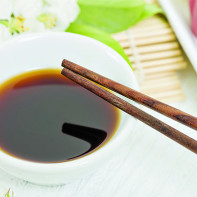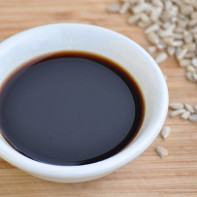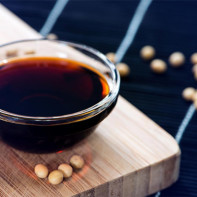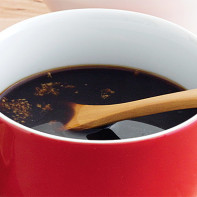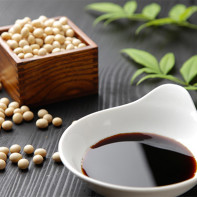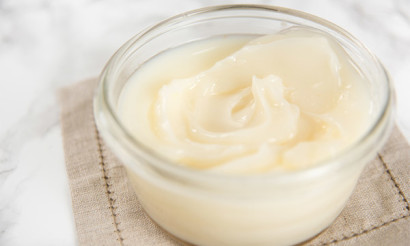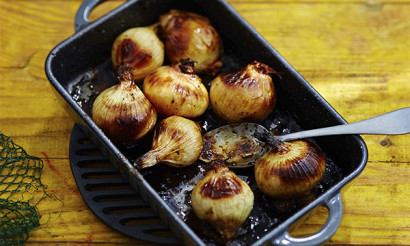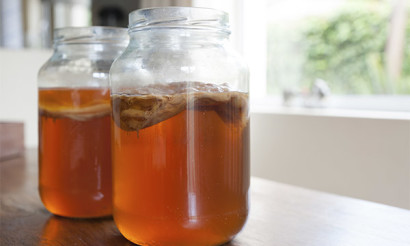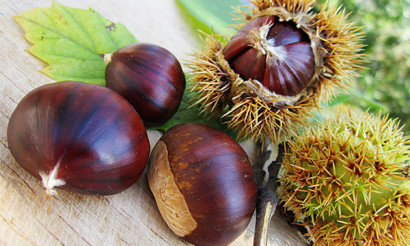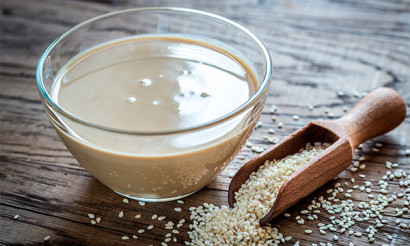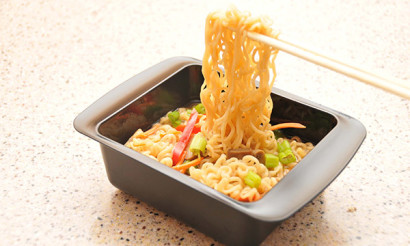Soy sauce: benefits and harms to the body
Soy sauce is a product of oriental cuisine, which has taken root well in Russian conditions. This is a seasoning of a liquid consistency and a very dark color. It has a characteristic odor that may seem harsh to some people. However, it is the presence of such an aroma that indicates that the buyer is a high-quality natural product. After all, this smell is the result of a long process of fermentation of soybeans and in a special way fried wheat or barley grains. Although not all of the ingredients for a traditional Chinese or Japanese recipe are commercially available, you can theoretically make the sauce at home.
- What soy sauce is made of
- Why soy sauce is salty
- Composition and calorie content
- What is soy sauce good for?
- For women
- For men
- During pregnancy
- When breastfeeding
- For kids
- Is soy sauce possible when losing weight
- Soy sauce in medicine
- With diabetes
- With pancreatitis
- With gastritis
- With gout
- With cholecystitis
- Soy sauce in cosmetology
- Cooking Application
- How can I replace soy sauce
- Harm and contraindications
- Soy Sauce Allergy Symptoms
- How to choose and store soy sauce
- How to make soy sauce at home
- Can I use soy sauce in fasting
- Interesting Facts
What soy sauce is made of
The traditional recipe for soy sauce involves a long fermentation process that lasts about two or three months. In the Chinese version, only soybeans participate in it. In Japanese - mentioned wheat grains, which give the sauce a light sour flavor. The fermentation process is carried out under the influence of the koji fungus.
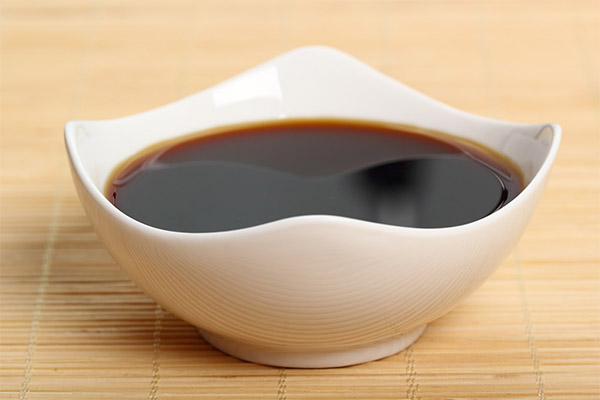
The longer the fermentation process lasts, the more saturated and harmonious soy sauce becomes. Of course, in modern conditions it will not work to spend a lot of time on its production. For this reason, many companies use a different technique - hydrolysis of soy proteins. Then the process proceeds much faster, and instead of several months, it takes only a couple of days until the moment of readiness. This helps to significantly reduce the final cost of the product. True, the taste will not be as intense as with traditional cooking.
There are manufacturers who mix the sauce obtained by hydrolysis with a small amount of natural. It costs a little more, but it turns out more aromatic and tasty.
So, in a classic Japanese sauce there should be only four main ingredients: the main one is soybeans, the additional ones are wheat or barley, water and salt. In the old days, soy sauce was made manually from these components. Today, the fermentation process takes place in the factory, and companies are trying to improve and automate production, even if using traditional recipes.
The process is carried out as follows - soybeans are soaked for a long time, and then stewed or boiled. Wheat grains are slightly fried and then ground to start the fermentation process. Salt is added to water until a solution of the desired consistency is obtained.
But at the same time it is impossible to cook a classic soy sauce without aspergillus - microscopic fungi. They are added to a mixture of already chopped wheat and prepared soy. These fungi create ideal conditions for the fermentation process. In the old days, this process simply could not give a predictable result, since the mixture was simply left in vats under the sun. Today, sauce is produced in factories where strictly defined environmental parameters are set so that the process develops properly and the product has the same taste and aroma regardless of the production batch.
When the wort (called koji) is considered finished, it is placed in tanks and brine is added. All this is thoroughly mixed. In Japanese tradition, the resulting wort is called moromi, and its fermentation period is several months.However, it would be more correct to say that not only alcoholic fermentation occurs, but also lactic acid fermentation. For most manufacturers, this takes several months, but for expensive brands that supply sauce to the imperial court, up to six months.
After this, the second wort is squeezed, poured into other containers, filtered, the residue is squeezed out using a press. The result is a raw sauce, which is left for several days in the tank so that the remaining microscopic suspensions settle in it. Then the sauce is heated, otherwise the fermentation process will not stop. By the way, at this stage it still remains transparent.
Why soy sauce is salty
Many people believe that soy sauce itself is salty solely due to the salt contained in the products. In fact, as mentioned above, salt is always added to the sauce in small quantities. This is not necessary for taste, but to prevent the propagation of pathogenic microorganisms. Due to the fact that the sauce has a pronounced taste and it contains a little salt, this makes it possible to less salt dishes cooked with it.
However, there is currently a slightly salted soy sauce on the market - less salt is added to it. Sweet sauce is also found, vinegar and sugar are added to it. Some manufacturers produce a special variety for sushi and sashimi. This sauce contains special seasonings for seafood. So, optionally, his taste should be salty.
Composition and calorie content
Soy sauce has a low energy value. It is only 60–70 kcal per 100 g, depending on the specific ingredients. At the same time, it contains a lot of useful ingredients, including proteins, vitamins and other active substances.
In general, the composition of the sauce can be represented as follows:
- Proteins - up to 7%. Moreover, in soy sauce contains a lot of essential amino acids that the body itself is not able to synthesize, but they are necessary for its normal functioning.
- Monosodium glutamate. Although most believe that it is just a flavor enhancer, and quite harmful, it is actually a free amino acid. In a small amount, it will not cause any harm, and to date there are no studies that would confirm its negative effect on the body under moderate consumption.
- Soy isoflavones. These are several substances at once - glycithin, genistein and daizdein with their glycosides. They generally have a beneficial effect on cardiovascular activity and even on the functioning of the brain.
- Antioxidants. They perform several functions at once, including accelerating the processes of metabolism, relieve inflammation, and slow down the aging process.
In addition, the composition of soy sauce includes ascorbic acid, vitamins of group B and PP. They normalize metabolic processes and lower the level of "bad" cholesterol.
What is soy sauce good for?
This product, due to its chemical composition, is useful to both men and women. Basically, its beneficial effect on the cardiovascular and reproductive system is distinguished.
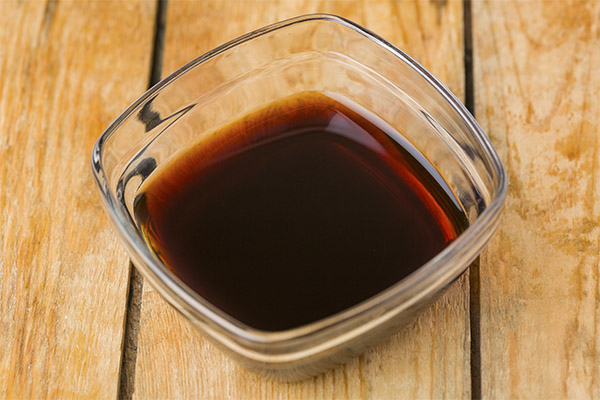
For women
The benefits of soy sauce for women were considered when studies showed that Japanese women tolerate menopause much better than representatives of other nationalities. A deeper study of the issue made it possible to find out that the whole point is in the use of soy sauce. So, in particular, experts from the University of Tokyo conducted a study showing that in Japanese women, whose diet includes soy sauce, the substance C-equol is actively released during menopause. In its properties, it partially compensates for the decrease in estrogen production during this period.
Soy sauce and other products based on soy as it turned out, help to eliminate various unpleasant symptoms of menopause, for example, hot flashes, as well as periodic pain in the joints.
Studies have shown that the aforementioned genistein helps fight osteoporosis and even prevents it (and this disease is typical mainly for women in whom calcium is washed out of bones at a fairly rapid rate during menopause).
Also, moderate regular consumption of soy sauce reduces the risk of developing breast cancer.
For men
Representatives of the stronger sex are more likely to encounter cardiovascular diseases. Therefore, for them, the property of soy sauce is more important to reduce the risk of developing such pathologies. Due to the presence of isoflavones, the product cleanses the walls of blood vessels from accumulations of cholesterol, which could transform into atherosclerotic plaques. In addition, these substances normalize blood pressure.
The high content of antioxidants in soy sauce enhances immunity. Their anti-inflammatory activity helps prevent prostatitis, reducing the risk of cancer of the prostate gland and other organs of the reproductive system.
However, men should be careful - phytohormones, that is, hormone-like substances of plant origin, enter soy sauce. But they are closer in their properties to estrogen, that is, to female sex hormones. When soy products are consumed in large quantities, the production of male sex hormones can decrease, and this leads to unpleasant consequences.
During pregnancy
For expectant mothers, this sauce is useful in that it allows you to add less salt to dishes. This means that the risk of swelling and hypertension is reduced. In addition, soy sauce contains many substances that will be useful to expectant mothers. For example, these are essential acids, B vitamins, including folic acid, antioxidants, iron, etc. Finally, the product allows you to establish the digestion process.
But you need to be careful, and if the future mother had attacks of acute gastritis or pancreatitis before pregnancy, it is better to refuse it.
When breastfeeding
In the postpartum period, soy sauce can quickly restore hormonal levels, strengthen bones, and normalize cardiovascular activity. But it can in some cases cause increased gas formation in the child. Therefore, until the child is 4 months old, do not use this sauce. If even after this age, the mother encounters colic or an allergic reaction in the baby, she will have to abandon soy sauce.
For kids
Children under 3 years of age should not be given soy sauce. However, this applies to any seasoning, since the digestive system of the child is not yet sufficiently developed. But gradually, soy sauce can be introduced into a children's diet in a small amount. For students, it is useful in that it favorably affects muscle development.
Is soy sauce possible when losing weight
Due to the fact that soy sauce contains less salt, it removes puffiness, along with which extra pounds go. At the same time, this product in itself is of low energy value. But thanks to the bright taste and aroma, it replaces much more fatty and high-calorie sauces and seasonings. For example, sour cream or ready-made mayonnaise, which, unlike homemade, poses a serious threat to the heart and figure. If desired, they can also replace olive or sunflower oil, but in a certain amount, fats are still needed.
At the same time, it should be remembered that soy sauce can only be consumed in small quantities. It contains monosodium glutamate, which enhances appetite, and because of this there is always a risk to eat more than expected (according to medical requirements).
Soy sauce in medicine
Currently, soy sauce is being studied by doctors - after all, along with other ingredients of oriental cuisine, it determines the longevity of the Japanese and the excellent state of health of the elderly.

With diabetes
With this disease, only foods with a low glycemic index can be consumed.In soy sauce, it is only 20 units, which allows you to include it in the diet, but only if it is a high-quality natural product. Be sure to read the composition of the sauce and make sure that there is nothing but soybeans, wheat grain, salt. Even the presence of additional spices is extremely undesirable, not to mention the presence of preservatives (such a product with diabetes will only do harm).
With pancreatitis
With this disease, soy sauce can adversely affect the non-pancreas. The fact is that its slightly salty and sour taste can stimulate the production of gastric juice and enhance the secretory function of the pancreatic gland. Therefore, its use will adversely affect the state of health. And this even applies to the classic sauce recipe, in which there are practically no ingredients other than soybeans and grain.
As for those recipes in which vinegar, various spices and garlic are added to soy sauce, such compounds can significantly enhance the inflammatory processes in the pancreas. Therefore, such sauces are absolutely contraindicated in any form of pancreatitis.
Natural soy sauce, obtained by prolonged natural fermentation, can be useful because it contains many vitamins and antioxidants with anti-inflammatory properties. But it is also impossible with acute pancreatitis, exacerbation of a chronic disease and in the case of unstable remission. In small quantities, soy sauce can be introduced into the diet only during a period of prolonged remission. But at the first signs of a worsening situation, or at least discomfort, it will again have to be ruled out.
With gastritis
Since soy sauce, like any other seasoning, stimulates the production of gastric juice, it should be discarded not only at the acute stage of the disease, but also at the stage of remission. But this only applies to gastritis with high acidity. With low acidity, you can use the product in small quantities.
With gout
Regarding the use of soy sauce for gout, doctors have no consensus. Some researchers believe that soy, like other legumes, will only increase the number of purines that provoke this disease. Others believe that after fermentation, soy sauce will just reduce the amount of purines. In any case, it is better not to take risks and include the product in the diet only from time to time and in small quantities.
With cholecystitis
With this disease, you need to reduce the use of salt and spices. They can easily be replaced with a quality sauce, which will consist of only the four ingredients listed above. But soy sauce with spicy additives should be discarded.
Soy sauce in cosmetology
The unique chemical composition of soy sauce allows its use in cosmetology. Due to its high content of antioxidants, it slows down the aging process and makes the skin more elastic. In addition, it improves the condition of the hair and helps to make them more luxuriant.
In home cosmetology, soy sauce is often used as a bleaching agent that helps get rid of freckles. To do this, it is recommended to wash your face in the morning and evening with brown, but not black sauce without the addition of spices.
Another recipe is used to get rid of acne. To do this, take 1 tbsp. sauce, mixed with the same amount of olive oil and fresh chicken yolk.This composition is applied to the face for 25 minutes, then washed thoroughly.
To make the hair thick and lush, make such a mask - mix 2 tsp. sauce with the same amount of olive oil, beat with one egg yolk and distribute evenly along the entire length of the hair. The product is left for an hour, then rinsed with ordinary shampoo.
Cooking Application
Soy sauce is an essential ingredient in oriental cuisine. However, today it is becoming part of the European culinary tradition, often replacing olive oil or mayonnaise. It is added to various salads, to meat and fish dishes.
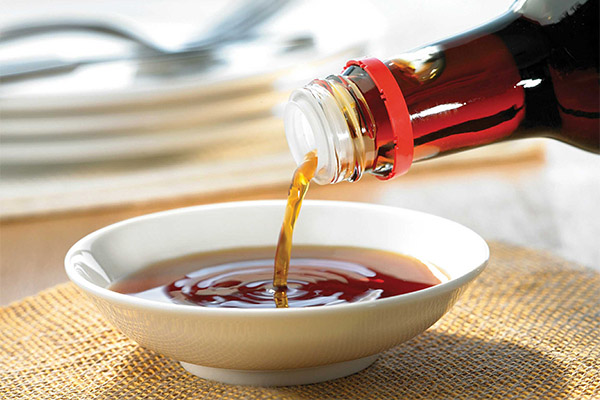
For example, you can mix soy sauce with olive oil and a small amount of fresh lemon juice - this will be a great dressing for any vegetable salad. It’s good to add a little sesame to it. It can also be mixed with mushroom, mustard, shrimp sauce.
Lighter sauce is considered universal, it can be used with any food, dark - complements meat dishes.
Soy sauce can be added to meat and vegetable dishes when stewed, as well as to soup during cooking. But you need to do this 10 minutes before readiness, so that the aroma has time to open. Only caution should be taken - no more than 1 tsp is added to soy sauce. to the pot. In the same amount, it can be used for rice dishes.
Based on soy sauce, lemon and herbs, you can cook marinades for meat and fish. This seasoning is also good in egg dishes. For example, you can beat an omelet with sour cream mixed with a little soy sauce. The dish will turn out magnificent, with a beautiful golden shade and delicate taste.
How can I replace soy sauce
To replace this ingredient, you need to find a seasoning that will recreate the oriental notes in the dish. The choice depends on the purpose of the sauce. If for marinade, then you need to take ordinary mayonnaise, add the same amount of water, red and black pepper, juice of one lemon and mix until smooth. This is a great marinade for barbecue.
If we are talking about soy sauce in a salad, then vinegar is taken to replace it, and preferably balsamic, because these unusual notes are already present in it. It can be mixed with olive oil and mustard added (best in powder).
Another salad dressing option is a vegetable oil mixed with apple cider vinegar, garlic and spices. To reproduce not only taste but also color, the oil is brought to a boil, and then chopped garlic is added. And only after cooling, it will be possible to add other ingredients.
Harm and contraindications
Soy sauce harm is a relative concept, basically all the adverse effects are associated either with its excessive use or with a poor-quality product bought on the market. The maximum allowable amount of soy sauce is 30 g per day. Exceeding this amount means flatulence and digestion at least.
But even the best quality sauce has its contraindications. These include:
- Gastrointestinal diseases, mainly such as peptic ulcer, colitis, etc., since the sauce can irritate the inflamed intestinal walls.
- Allergies and hormonal diseases caused by excess estrogen.
Some researchers also believe that soy sauce should not be consumed with migraines, as it will only aggravate a headache.
Soy Sauce Allergy Symptoms
The signs of an allergic reaction are the same as with any other food intolerance. This dyspeptic symptoms, nausea, vomiting, abdominal pain, rash, especially on the hands and face. With these signs, you need to start taking antihistamines.
How to choose and store soy sauce
Be sure to read the composition in the store.As a rule, you can distinguish natural from synthetic sauce even when comparing prices. In a quality product there will be only 4 ingredients, with a protein content of 6-8% should be indicated. And even if its fermentation was accelerated artificially, it is better than a sauce with dyes, flavor enhancers and flavorings. In unscrupulous manufacturers, the composition may also include hydrochloric or sulfuric acid. But in fact, they should not be.
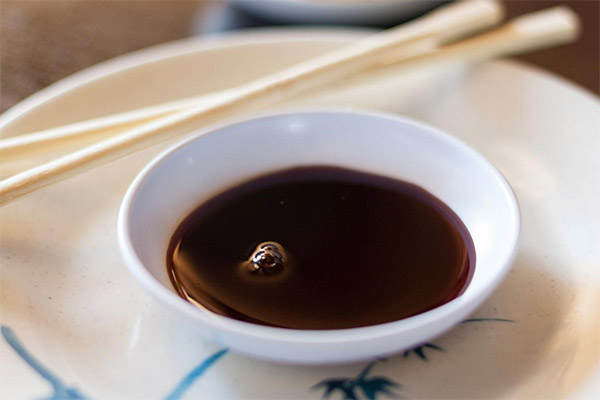
Quality sauce is always sold exclusively in glass bottles. It should have a pronounced brown tint, you need to consider it in light - the liquid should be transparent, without sediment. The label should indicate that this is natural fermentation. An artificial product looks cloudy, and in consistency it may look like syrup. The chemical sauce seems sharper and salty to the taste, it can leave an unpleasant aftertaste, but, of course, it will not be possible to try the product in the store.
Store the sauce in accordance with the manufacturer's recommendations. A sealed container can be kept in the kitchen cabinet. After opening the bottle, it should be placed in the refrigerator. For more than two months, keeping it open is not recommended.
How to make soy sauce at home
Although there are many varieties of soy sauce in stores today, there is no guarantee that all this is a quality product made without preservatives or colorings. But you can make soy sauce at home to be sure that there are no harmful ingredients.
To do this, you need 120 g of soybeans, 2 tbsp. softened butter, 1 tbsp. wheat flour, mushroom broth - 50 ml, sea salt to taste. Soybeans need to be boiled and chopped in a blender to a puree state, then add other ingredients to them and put the mixture on fire. Simmer the sauce on fire until boiling, then turn it off and let cool.
Can I use soy sauce in fasting
Soy sauce does not contain animal ingredients. In the post it can be consumed with vegetable dishes to diversify the table.
Interesting Facts
Although Japan and China dispute each other's primacy in the preparation of soy sauce, it still came to Europe from the Land of the Rising Sun. Moreover, the Europeans themselves did not know soya at that time. And until the beginning of the twentieth century, in most languages, the word "soy" meant sauce, not beans.
The characteristic color of this sauce is the result of chemical transformations, the so-called Maillard reaction. She also makes the pastries rosy, forms a delicious crust on a piece of fried meat, etc. In this process, sugars react with amino acids (in the case of sauce, there are almost two dozen of them). The resulting taste and color will be completely determined by such a reaction, and not by the type of feedstock.
«Important: all information on the site is provided exclusively in fact-finding purposes. Before applying any recommendations, consult with a profile specialist. Neither the editors nor the authors are liable for any possible harm caused materials. "

